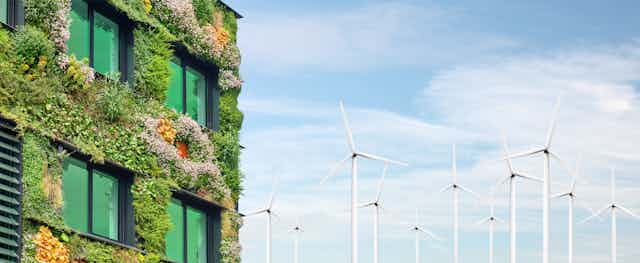A move away from fossil fuels to renewables is urgently required, according to experts at the Intergovernmental Panel on Climate Change. Yet building, operating, and maintaining a low-carbon energy system requires big energy investments. Those investments reduce the net energy available to society, and yield complex socio-economic implications.
As part of a team of 22 international authors, I unpack these knock-on effects in a paper recently published by the Royal Society of Chemistry. Together, we call for a greater account of net energy to better shape just transition pathways that prioritise people and communities in all parts of the globe.
Understanding net energy
The production and exchange of goods and services are made possible by several ingredients. A major one is energy. Net energy is that which is supplied to society minus the energy invested in extracting, processing, and delivering it.
Net energy is expected to decline – perhaps only temporarily. That’s because a rapid, large-scale deployment of renewables and associated infrastructure requires a lot of energy. It is also due to the fact that supplies of fossil fuels deplete and demand more energy for their extraction.
The net energy approach reveals a window of opportunity for a global inclusive transition, bounded by two limits (see below). At the upper limit, the transition cannot be too rapid, as society needs enough net energy to function without too much disruption. The lower limit is dictated by the minimum speed required to meet ambitious climate targets.

As the transition lags, these limits move closer to each other, shrinking the window of opportunity for an inclusive global transition. The upper one is expected to contract over time due to geological depletion of fossil fuels, and as rapid low-carbon investment consumes a higher proportion of energy. The lower limit will become more pressing because the longer the transition takes, the less chance there is of meeting ambitious climate targets.
Huge risks for developing countries
Every country that delays action risks compromising its ability to transition to low-carbon energy sources, while maintaining or achieving high levels of wellbeing. Competition for energy and material resources necessary for the transition may be exacerbated, especially for developing countries which are already at a clear disadvantage.
As more developed countries are likely to make their transition first, developing countries may risk getting slowed down – or even trapped – in their progress towards modern low-carbon energy. This situation further raises equity questions as they are the lest responsible for, and most affected by, climate change.
Three actions could enhance the justice of the transition. First, developed countries should assume their responsibility for ecological breakdown and the excessive use of materials. Massive financial support and technology transfers to developing countries are needed. Second, societies need to switch to more efficient ways of using energy (for example, from gasoline-powered to electric cars or bicycles). Third, unnecessary energy uses (such as the prolific use of private jets) needs to stop, especially for certain socio-economic groups mostly within developed countries, to ensure there is sufficient energy for everybody.
Research furthermore suggests that a decent quality of life can be sustained with much lower levels of energy use than currently observed in affluent nations. So embracing demand reduction in those countries not only aligns with climate goals but also fosters a more sustainable and equitable society.
Modelling for a just transition
Looking at net energy improves our understanding of how energy and economy interact. This comprehension is later used to produce transition scenarios thanks to mathematical models. Yet most of them tend to overlook net energy.
Reasons for this are various but, according to our collective, fall into three categories. First, most models lack proper representation of the energy and material flows of the goods and services provided. Second, most models still use economics theories where increases in energy costs cannot significantly affect GDP growth. Thus models not only downplay the contribution of energy in economic processes, but also set aside its interaction with money and the financial sector, which is largely unconsidered too. Third, the current framework of climate change scenarios nurtures a simplistic and technocratic vision of the economy. As such, little is assumed regarding interdependence among population, economic growth, and other parameters such as net energy.
To improve the consideration of net energy, we propose a series of six measures. Some concern the data used in the models, others the methodology and still others the scenarios. For instance, we support the exploration of new mitigation pathways limiting the reliance on carbon dioxide removal, and equitable low-growth and post-growth scenarios. We believe following the measures is further timely as the Intergovernmental Panel on Climate Change is currently discussing ways to produce more relevant knowledge for climate action.
Our work underlines that the window of opportunity for an inclusive global transition is shrinking as we lag behind. Radical and decisive action is required to make the transition a just one. The sooner we act, the bigger the gains.

Don’t have time to read about climate change as much as you’d like?
Get a weekly roundup in your inbox instead. Every Wednesday, The Conversation’s environment editor writes Imagine, a short email that goes a little deeper into just one climate issue. Join the 30,000+ readers who’ve subscribed so far.

